- Home
- Robert Graves
The Greek Myths, Volume2 Page 4
The Greek Myths, Volume2 Read online
Page 4
2. Strabo’s historical view, however, even if archaeologically plausible, does not account for Tantalus’s connexion with Argos, Corinth, and Cretan Miletus. The rock poised over him in Tartarus, always about to fall, identifies him with Sisyphus of Corinth, whose similarly perpetual punishment was deduced from an icon which showed the Sun-Titan laboriously pushing the sun-disk up the slope of Heaven to its zenith (see 67.2). The scholiast on Pindar was dimly aware of this identification, but explained Tantalus’s punishment rationalistically, by recording that: ‘some understand the stone to represent the sun, and Tantalus, a physicist, to be paying the penalty for having proved that the sun is a mass of white-hot metal’ (scholiast on Pindar’s Olympian Odes i. 97). Confusingly, this icon of the Sun-Titan has been combined with another: that of a man peering in agony through an interlace of fruit-bearing boughs, and up to his chin in water – a punishment which the rhetoricians used as an allegory of the fate meted out to the rich and greedy (Servius on Virgil’s Aeneid vi. 603; Fulgentius: Mythological Compendium ii. 18). The apples, pears, figs, and such-like, dangling on Tantalus’s shoulders are called by Fulgentius ‘Dead Sea fruit’, of which Tertullian writes that ‘as soon as touched with the finger, the apple turns into ashes.’
3. To make sense of this scene, it must be remembered that Tantalus’s father Tmolus is described as having been wreathed with oak, and that his son Pelops, one of whose grandsons was also called Tantalus (see 112. c), enjoyed hero-rites at Olympia, in which ‘Zeus’s forester’ took part. Since, as is now generally agreed, the criminals in Tartarus were gods or heroes of the pre-Olympian epoch, Tantalus will have represented the annual Sacred King, dressed in fruit-hung branches, like those carried at the Oschophoria (see 98. w), who was flung into a river as a pharmacos – a custom surviving in the Green George ritual of the Balkan countryside, described by Frazer. The verb tantalize, derived from this myth, has prevented scholars from realizing that Tantalus’s agony is caused not by thirst, but by fear of drowning or of subsequent immolation on a pyre, which was the fate of his ugly son Broteas.
4. Plato (Cratylus 28) may be right when he derives Tantalus from talantatos, ‘most wretched’, formed from the same root, tla, ‘suffering’, or ‘enduring’, which yields the names of Atlas and Telamon, both oak heroes. But talanteuein means ‘to weigh out money’, and may be a reference to his riches; and talanteuesthai can mean ‘to lurch from side to side’, which is the gait of the sacred king with the lame thigh (see 23. 1). It seems, then, that Tantalus is both a Sun-Titan and a woodland king, whose worship was brought from Greece to Asia Minor by way of Crete – Pandareus is described as a Cretan – in the mid-second millennium B.C., and reimported into Greece towards its close, when the collapse of the Hittite Empire forced wealthy Greek-speaking colonists of Asia Minor to abandon their cities.
5. When the mythographers recorded that Tantalus was a frequent guest on Olympus, they were admitting that his cult had once been dominant in the Peloponnese; and, although the banquets to which the gods invited Tantalus are carefully distinguished from the one to which he invited them, in every case the main dish will have been the same umble soup which the cannibalistic Arcadian shepherds of the oak cult prepared for Wolfish Zeus (see 38. b). It is perhaps no coincidence that, in Normandy, the Green George victim is called ‘Green Wolf’, and was formerly thrown alive into the midsummer bonfire. The eating of Pelops, however, is not directly connected with the wolf cult. Pelops’s position as Poseidon’s minion, his name, ‘muddy face’, and the legend of his ivory shoulder, point rather to a porpoise cult on the Isthmus (see 8.3 and 70. 5) – ‘dolphin’ in Greek includes the porpoise – and suggests that the Palladium, said to have been made from his bones (see 159. 3 and 166. h), was a cult object of porpoise ivory. This would explain why, according to the scholiast on Pindar’s Olympian Odes i. 37, Thetis the Sea-goddess, and not Demeter, ate Pelops’s shoulder. But the ancient seated statue of Mare-headed Demeter at Phigalia held a dove in one hand, a dolphin (or porpoise) in the other; and, as Pausanias directly says: ‘Why the image was thus made is plain to anyone of ordinary intelligence who has studied mythology’ (viii. 43.3). He means that she presided over the horse cult, the oak cult, and the porpoise cult.
6. This ancient myth distressed the later mythographers. Not content with exculpating Demeter from the charge of deliberate man-eating, and indignantly denying that all the gods ate what was set before them, to the last morsel, they invented an over-rationalistic explanation of the myth. Tantalus, they wrote, was a priest who revealed Zeus’s secrets to the uninitiated. Whereupon the gods unfrocked him, and afflicted his son with a loathsome disease; but the surgeons cut him about and patched him up with bone-graftings, leaving scars which made him look as if he had been hacked in pieces and joined together again (Tzetzes: On Lycophron 152).
7. Pandareus’s theft of the golden mastiff should be read as a sequel to Heracles’s theft of Cerberus, which suggests the Achaeans’ defiance of the death curse, symbolized by a dog, in their seizure of a cult object sacred to the Earth-goddess Rhea (Tantalus’s grandmother), and conferring sovereignty on its possessor. The Olympian goddesses were clearly abetting Pandareus’s theft, and the dog, though Rhea’s property, was guarding the sanctuary of the annually dying Cretan Zeus; thus the myth points not to an original Achaean violation of Rhea’s shrine, but to a temporary recovery of the cult object by the goddess’s devotees.
8. The nature of the stolen cult object is uncertain. It may have been a golden lamb, the symbol of Pelopid sovereignty; or the cuckoo-tipped sceptre which Zeus is known to have stolen from Hera; or the porpoise-ivory Palladium; or the aegis bag with its secret contents. It is unlikely to have been a golden dog, since the dog was not the cult object, but its guardian; unless this is a version of the Welsh myth of Amathaon ap Don who stole a dog from Arawn (‘eloquence’) King of Annwm (‘Tartarus’) and was by its means enabled to guess the secret name of the god Bran (White Goddess pp. 30 and 48–53).
9. The three daughters of Pandareus, one of whom, Cameiro, bears the same name as the youngest of the three Rhodian Fates (see 60. 2), are the Triple-goddess, here humiliated by Zeus for her devotees’ rebellion. Tantalus’s loyalty to the goddess is shown in the stories of his son Broteas, who carved her image on Mount Sipylus, and of his daughter Niobe, priestess of the White Goddess, who defied the Olympians and whose bird was the white swan-eagle of Lake Tantalis. Omphale, the name of Tantalus’s mother, suggests a prophetic navel-shrine like that at Delphi.
10. The annual pharmacos was chosen for his extreme ugliness, which accounts for Broteas. It is recorded that in Asia Minor, the pharmacos was first beaten on the genitals with squill (see 26.3) to the sound of Lydian flutes – Tantalus (Pausanias: ix. 5. 4) and his father Tmolus (Ovid: Metamorphoses ii. 156) are both associated in legend with Lydian flutes – then burned on a pyre of forest wood; his ashes were afterwards thrown into the sea (Tzetzes: History xxiii. 726–56, quoting Hipponax – sixth century B.C.). In Europe, the order seems to have been reversed: the Green George pharmacos was first ducked, then beaten, and finally burned.
109
PELOPS AND OENOMAUS
PELOPS inherited the Paphlagonian throne from his father Tantalus, and for a while resided at Enete, on the shores of the Black Sea, whence he also ruled over the Lydians and Phrygians. But he was expelled from Paphlagonia by the barbarians, and retired to Lydian Mount Sipylus, his ancestral seat. When Ilus, King of Troy, would not let him live in peace even there, but ordered him to move on, Pelops brought his fabulous treasures across the Aegean Sea. He was resolved to make a new home for himself and his great horde of followers,1 but first to sue for the hand of Hippodameia, daughter of King Oenomaus, the Arcadian, who ruled over Pisa and Elis.2
b. Some say that Oenomaus had been begotten by Ares on Harpina, daughter of the River-god Asopus; or on the Pleiad Asterië; or on Asterope; or on Eurythoë, daughter of Danaus; while others call him the son of Alxion; or of Hyperochus.3
c. By his wife Sterope, or Euarete, daughter of Acrisius, Oenomaus became the father of Leucippus, Hippodamus, and Dysponteus, founder of Dyspontium; and of one daughter, Hippodameia.4 Oenomaus was famous for his love of horses, and forbade his subjects under the penalty of a curse ever to mate mares with asses. To this day, if the Eleans need mules, they must take their mares abroad to mate and foal.5
d. Whether he had been warned by an oracle that his son-in-law would kill him, or whether he had himself fallen in love with Hippodameia, is disputed; but Oenomaus devised a new way to prevent her from ever getting married. He challenged each of Hippodameia’s suitors in turn to a chariot race, and laid out a long course from Pisa, which lies beside the river Alpheius, opposite Olympia, to Poseidon’s altar on the Isthmus of Corinth. Some say that the chariots were drawn by four horses;6 others say, by two. Oenomaus insisted that Hippodameia must ride beside each suitor, thus distracting his attention from the team – but allowed him a start of half an hour or so, while he himself sacrificed a ram on the altar of Warlike Zeus at Olympia. Both chariots would then race towards the Isthmus and the suitor, if overtaken, must die; but should he win the race, Hippodameia would be his, and Oenomaus must die.7 Since, however, the wind-begotten mares, Psylla and Harpinna, which Pelops’s father Ares had given him, were immeasurably the best in Greece, being swifter even than the North Wind;8 and since his chariot, skilfully driven by Myrtilus, was especially designed for racing, he had never yet failed to overtake his rival and transfix him with his spear, another gift from Ares.9
e. In this manner Oenomaus disposed of twelve or, some say, thirteen princes, whose heads and limbs he nailed above the gates of his palace, while their trunks were flung barbarously in a heap on the ground. When he killed Marmax, the first suitor, he also butchered his mares, Parthenia and Eripha, and buried them beside the river Parthenia, where their tomb is still shown. Some say that the second suitor, Alcathous, was buried near the Horse-scarer in the hippodrome at Olympia, and that it is his spiteful ghost which baulks the charioteers.10
f. Myrtilus, Oenomaus’s charioteer, was the son of Hermes by Theobule, or Cleobule; or by the Danaid Phaethusa; but others say that he was the son of Zeus and Clymene. He too had fallen in love with Hippodameia, but dared not enter the contest.11 Meanwhile, the Olympians had decided to intervene and put an end to the slaughter, because Oenomaus was boasting that he would one day build a temple of skulls: as Evenus, Diomedes, and Antaeus had done.12 When therefore Pelops, landing in Elis, begged his lover Poseidon, whom he invoked with a sacrifice on the seashore, either to give him the swiftest chariot in the world for his courtship of Hippodameia, or to stay the rush of Oenomaus’s brazen spear, Poseidon was delighted to be of assistance. Pelops soon found himself the owner of a winged golden chariot, which could race over the sea without wetting the axles, and was drawn by a team of tireless, winged, immortal horses.13
g. Having visited Mount Sipylus and dedicated to Temnian Aphrodite an image made of green myrtle-wood, Pelops tested his chariot by driving it across the Aegean Sea. Almost before he had time to glance about him, he had reached Lesbos, where his charioteer Cillus, or Cellas, or Cillas, died because of the swiftness of the flight. Pelops spent the night on Lesbos and, in a dream, saw Cillus’s ghost lamenting his fate, and pleading for heroic honours. At dawn, he burned his body, heaped a barrow over the ashes, and founded the sanctuary of Cillaean Apollo close by. Then he set out again, driving the chariot himself.14
h. On coming to Pisa, Pelops was alarmed to see the row of heads nailed above the palace gates, and began to regret his ambition. He therefore promised Myrtilus, if he betrayed his master, half the kingdom and the privilege of spending the bridal night with Hippodameia when she had been won.15
i. Before entering the race – the scene is carved on the front gable of Zeus’s temple at Olympia – Pelops sacrificed to Cydonian Athene. Some say that Cillus’s ghost appeared and undertook to help him; others, that Sphaerus was his charioteer; but it is more generally believed that he drove his own team, Hippodameia standing beside him.16
j. Meanwhile, Hippodameia had fallen in love with Pelops and, far from hindering his progress, had herself offered to reward Myrtilus generously, if her father’s course could by some means be checked. Myrtilus therefore removed the lynch-pins from the axles of Oenomaus’s chariot, and replaced them with others made of wax. As the chariots reached the neck of the Isthmus and Oenomaus, in hot pursuit, was poising his spear, about to transfix Pelops’s back, the wheels of his chariot flew off, he fell entangled in the wreckage and was dragged to death. His ghost still haunts the Horse-scarer at Olympia.17 There are some, however, who say that the swiftness of Poseidon’s winged chariot and horses easily enabled Pelops to out-distance Oenomaus, and reach the Isthmus first; whereupon Oenomaus either killed himself in despair, or was killed by Pelops at the winning-post. According to others, the contest took place in the Hippodrome at Olympia, and Amphion gave Pelops a magic object which he buried by the Horse-scarer, so that Oenomaus’s team bolted and wrecked his chariot. But all agree that Oenomaus, before he died, laid a curse on Myrtilus, praying that he might perish at the hands of Pelops.18
k. Pelops, Hippodameia, and Myrtilus then set out for an evening drive across the sea. ‘Alas!’ cried Hippodameia, ‘I have drunk nothing all day; thirst parches me.’ The sun was setting and Pelops called a halt at the desert island of Helene, which lies not far from the island of Euboea, and went up the strand in search of water. When he returned with his helmet filled, Hippodameia ran weeping towards him and complained that Myrtilus had tried to ravish her. Pelops sternly rebuked Myrtilus, and struck him in the face, but he protested indignantly: ‘This is the bridal night, on which you swore that I should enjoy Hippodameia. Will you break your oath?’ Pelops made no reply, but took the reins from Myrtilus and drove on.19 As they approached Cape Geraestus – the southernmost promontory of Euboea, now crowned with a remarkable temple of Poseidon – Pelops dealt Myrtilus a sudden kick, which sent him flying head-long into the sea; and Myrtilus, as he sank, laid a curse on Pelops and all his house.20
l. Hermes set Myrtilus’s image among the stars as the constellation of the Charioteer; but his corpse was washed ashore on the coast of Euboea and buried in Arcadian Pheneus, behind the temple of Hermes; once a year nocturnal sacrifices are offered him there as a hero. The Myrtoan Sea, which stretches from Euboea, past Helene, to the Aegean, is generally believed to take its name from Myrtilus rather than, as the Euboeans insist, from the nymph Myrto.21
m. Pelops drove on, until he reached the western stream of Oceanus, where he was cleansed of blood guilt by Hephaestus; afterwards he came back to Pisa, and succeeded to the throne of Oenomaus. He soon subjugated nearly the whole of what was then known as Apia, or Pelasgiotis, and renamed it the Peloponnese, meaning ‘the island of Pelops’, after himself. His courage, wisdom, wealth, and numerous children, earned him the envy and veneration of all Greece.22
n. From King Epeius, Pelops took Olympia, and added it to his kingdom of Pisa; but being unable to defeat King Stymphalus of Arcadia by force of arms, he invited him to a friendly debate, cut him in pieces, and scattered his limbs far and wide; a crime which caused a famine throughout Greece. But his celebration of the Olympian Games in honour of Zeus, about a generation after that of Endymion, was more splendid than any before.
o. To atone for the murder of Myrtilus, who was Hermes’s son, Pelops built the first temple of Hermes in the Peloponnese; he also tried to appease Myrtilus’s ghost by building a cenotaph for him in the hippodrome at Olympia, and paying him heroic honours. Some say that neither Oenomaus, nor the spiteful Alcathous, nor the magic object which Pelops buried, is the true Horse-scarer: it is the ghost of Myrtilus.23
p. Over the tomb of Hippodameia’s unsuccessful suitors, on the farther side of the river Alpheius, Pelops raised a tall barrow, paying them heroic honours too; and about a furlong away stands the sanctuary of Artemis Cordax, so called because Pelops’s fol
lowers there celebrated his victories by dancing the Rope Dance, which they had brought from Lydia.24
q. Pelops’s sanctuary, where his bones are preserved in a brazen chest, was dedicated by Tirynthian Heracles, his grandson, when he came to celebrate the Olympian Games; and the Elean magistrates still offer Pelops the annual sacrifice of a black ram, roasted on a fire of white poplar-wood. Those who partake of this victim are forbidden to enter Zeus’s temple until they have bathed, and the neck is the traditional perquisite of his forester. The sanctuary is thronged with visitors every year, when young men scourge themselves at Pelops’s altar, offering him a libation of their blood. His chariot is shown on the roof of the Anactorium in Phliasia; the Sicyonians keep his gold-hilted sword in their treasury at Olympia; and his spear-shaped sceptre, at Chaeronea, is perhaps the only genuine work of Hephaestus still extant. Zeus sent it to Pelops by the hand of Hermes, and Pelops bequeathed it to King Atreus.25

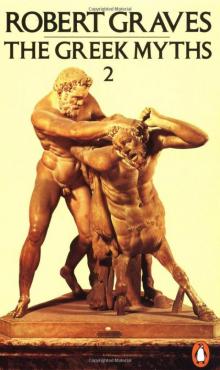 The Greek Myths, Volume2
The Greek Myths, Volume2 The Anger of Achilles: Homer's Iliad
The Anger of Achilles: Homer's Iliad Count Belisarius
Count Belisarius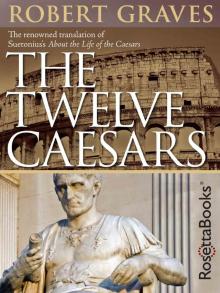 The Twelve Caesars
The Twelve Caesars Complete Poems 3 (Robert Graves Programme)
Complete Poems 3 (Robert Graves Programme) Homer's Daughter
Homer's Daughter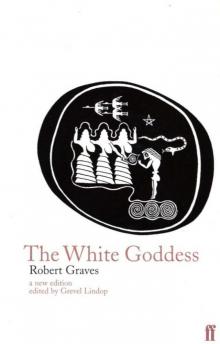 The White Goddess
The White Goddess Goodbye to All That
Goodbye to All That Claudius the God and His Wife Messalina
Claudius the God and His Wife Messalina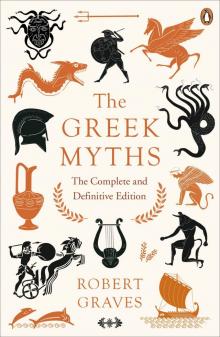 The Greek Myths
The Greek Myths I, Claudius
I, Claudius The Islands of Unwisdom
The Islands of Unwisdom Complete Short Stories
Complete Short Stories The Golden Fleece
The Golden Fleece They Hanged My Saintly Billy
They Hanged My Saintly Billy King Jesus
King Jesus Sergeant Lamb's America
Sergeant Lamb's America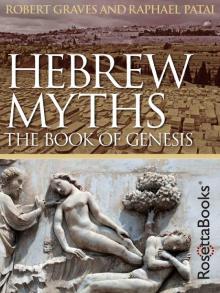 Hebrew Myths: The Book of Genesis
Hebrew Myths: The Book of Genesis Seven Days in New Crete
Seven Days in New Crete Proceed, Sergeant Lamb
Proceed, Sergeant Lamb Claudius the God
Claudius the God Wife to Mr. Milton
Wife to Mr. Milton The Complete Poems
The Complete Poems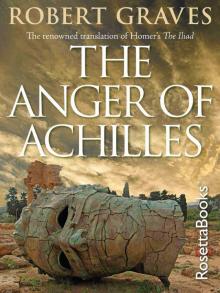 The Anger of Achilles
The Anger of Achilles Claudius the God c-2
Claudius the God c-2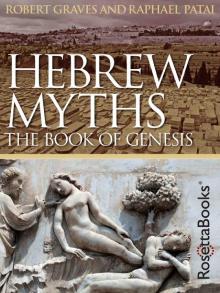 Hebrew Myths
Hebrew Myths I, Claudius c-1
I, Claudius c-1 The Greek Myths, Volume 1
The Greek Myths, Volume 1